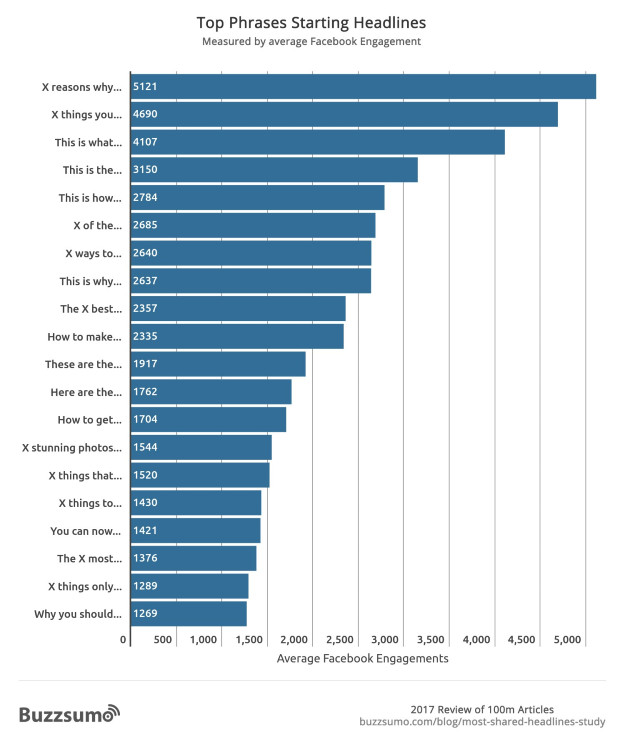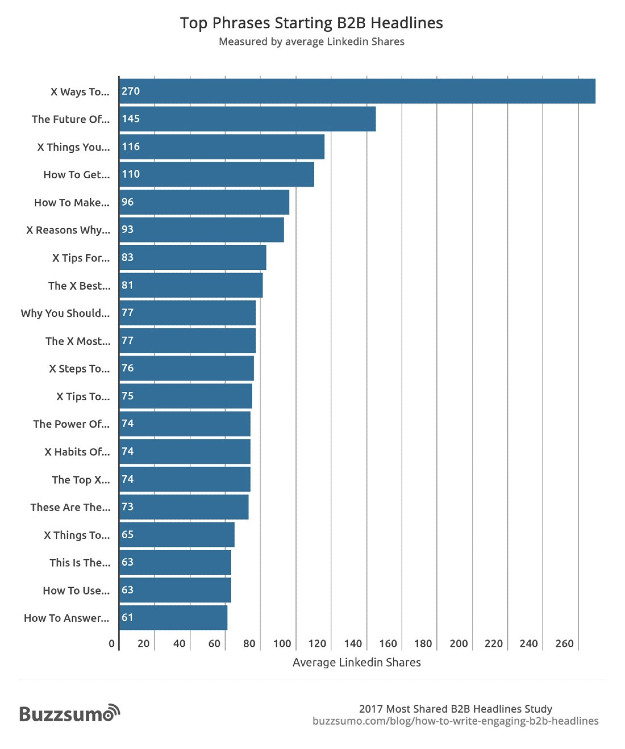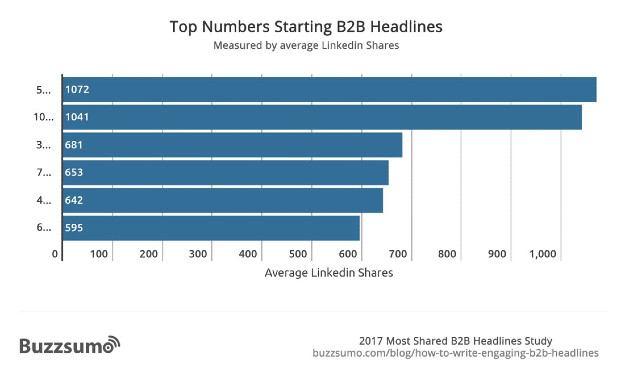The legends of copywriting agree on a universal truth: It can destroy or skyrocket your marketing campaign.
"It" is your headline.
And that makes sense: The headline is the first thing that gets noticed. If people don't read your headline, they don't go on to read your ad/content/email/etc.
Let's Look at Some Headline Statistics
Using numbers in your ad or content has been proven effective.
BuzzSumo analyzed 100 million headlines and found that the top starting phrase of headlines that had the most Facebook Engagements were...
- #1: "X Reasons Why..."
- #2: "X Things You..."

That finding is similar for the B2B crowd on LinkedIn, with two of the top 3 most shared posts starting with numbers in the headline:
- #1: "X Ways To..."
- #3: "X Things You..."

What's more, the top numbers are 10, 5, 15, and 7:

Similarly, for LinkedIn, 5 and 10 far outrank others:

A Three-Step Formula Proven to Work
So now that we know that makes up the most popular headlines, how can we actually apply that information to reach our prospective customers?
Because if something doesn't apply to your readers, then they're not going to be interested.
"But I don't want to be like all those other places that use clickbait headlines!"
If your content doesn't deliver... well, then it is in fact just clickbait.
But if it's actually worth reading, if it brings value... then, using the headlines that work?
That's just being smart.
So how do we actually go about creating a headline around what our prospective customers want?
Let's try a tried-and-true formula.
The Amazing E-T-C Headline Formula
I use this formula to perfect a headline. Let's call it the E-T-C method. Unlike miscellaneous other advice you read, etc., etc., this one will stick.
You take...
- The end result your customer wants +
- The time they can get it in +
- Conquer the objections they will have
So, just like for this article title:
- What do you want? To get your (potential) customer's attention.
- What's an objection you might have? I'm not a marketer or advertising person.
- When can I get this result? In just five minutes, after you read this article.
Other examples:
- [How to Get More Sales] + [In 7 Days] + [Without Being an Extrovert]
- [Get in Front of Big-Time CEOs] + [in 3 Business Days] + [Without Going Through Gatekeepers]
- [Get More Customers Walking Through Your Door] + [in 2 Weeks] + [Without Expensive Monthly Marketing Contracts]
- [10x Your Productivity With Remote Meetings] + [in Less Than 3 Months] + [Without Your Boss's Approval]
Breaking the E-T-C Rules
Understand, though, that you don't need all three elements, all the time:
- Using the end result is not bad: Get More Customers Contacting You
- Using the end result and the time frame is getting better: Get More Customers Contacting You in 7 Days
- Using the end result, the time frame, and conquering objections is fantastic: Get More Customers Contacting You in 7 Days Without Blowing Your Entire Quarter's Profits on a Website
The E-T-A Method
You can also tweak the formula for your reader to take action toward their desired result:
- The end result your customer wants +
- The time they can get it in +
- Action they need to take to get it
Examples:
- [I'll Get You More Online Sales] + [After 10 Minutes] + [on the Phone With Me]
- [Get Sales-Driving Feedback on Your Product] + [by Letting Me Write Your Emails] + [in Just One Day]
- [Get More Product Signups] + [in 30 Minutes] + [After Watching my Case Study Webinar]
- [Do This to Warm Up Prospects] + [10 Minutes Before a Meeting] + [by Watching This Video]
Why Does All That Work So Well?
When your headline is both concise and comprehensive, it quickly tells your reader what your product/service will do for them. It especially works if...
- You're giving clarity versus being clever. If your reader had a countdown timer for the end of the world that would go off if they couldn't clearly understand your headline, would you still use it?
- You're using your customer's lingo. Just because a headline has to have clarity does not mean it has to make sense or appeal to everyone. Your ad should act as a sifter. The people who are naturally interested in what you have to offer will fall through and reading your ad/content/email.
- You're hitting on their biggest pain point/desire. The best headlines stop people in their tracks and stir up emotions and curiosity. Amazing headlines cause people to perk up, stop what they're doing, and read more about what you're talking about.
- You're writing to one person. Even though your copy is going out to many people, write as if you were talking to one person. "I, you, me" versus "we, our, they." It feels personal and makes it feel as though you are addressing the reader as a person. Pretend you're having coffee with a prospective customer.
- You're giving them direct instruction on what to do next. It may not be possible in your headline unless you're using the E-T-A Method, but most online ads allow you to have a call to action.
- It's about your customer, not your product. People love talking about themselves, and by extension their product/service. But you have to define your customer's problem better than they know it themselves; that happens when you think from their point of view and talk about them, versus you and your product.
'What Can I Do Next?'
You've got a great framework to start with for your headlines.
So, what headline will you create today to start getting the attention of your readers?
Of course, mastering headlines is one thing, writing an entire sales page or web copy is another. It can be daunting. But don't get discouraged. You don't have to go it alone. You can get help if you need it.




